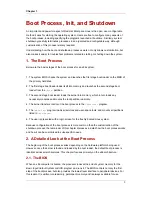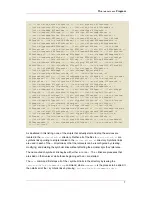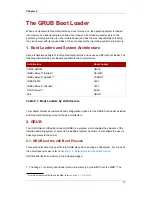
2
Refer to
Section 3.11, “
/proc/tty/
”
for more information about
tty
devices.
3
Refer to
Section 5.2, “Runlevel 5”
for more information about display managers.
Tip
After the system is finished booting, it is possible to log in as root and execute
these same scripts to start and stop services. For instance, the command
/etc/rc.d/init.d/httpd stop
stops the Apache HTTP Server.
Each of the symbolic links are numbered to dictate start order. The order in which the services
are started or stopped can be altered by changing this number. The lower the number, the
earlier it is started. Symbolic links with the same number are started alphabetically.
Note
One of the last things the
init
program executes is the
/etc/rc.d/rc.local
file. This file is useful for system customization. Refer to
Section 3, “Running
Additional Programs at Boot Time”
for more information about using the
rc.local
file.
After the
init
command has progressed through the appropriate
rc
directory for the runlevel,
the
/etc/inittab
script forks an
/sbin/mingetty
process for each virtual console (login
prompt) allocated to the runlevel. Runlevels 2 through 5 have all six virtual consoles, while
runlevel 1 (single user mode) has one, and runlevels 0 and 6 have none. The
/sbin/mingetty
process opens communication pathways to tty devices
2
, sets their modes, prints the login
prompt, accepts the user's username and password, and initiates the login process.
In runlevel 5, the
/etc/inittab
runs a script called
/etc/X11/prefdm
. The
prefdm
script
executes the preferred X display manager
3
—
gdm
,
kdm
, or
xdm
, depending on the contents of
the
/etc/sysconfig/desktop
file.
Once finished, the system operates on runlevel 5 and displays a login screen.
3. Running Additional Programs at Boot Time
The
/etc/rc.d/rc.local
script is executed by the
init
command at boot time or when
changing runlevels. Adding commands to the bottom of this script is an easy way to perform
necessary tasks like starting special services or initialize devices without writing complex
initialization scripts in the
/etc/rc.d/init.d/
directory and creating symbolic links.
The
/etc/rc.serial
script is used if serial ports must be setup at boot time. This script runs
Chapter 1. Boot Process, Init...
8
Summary of Contents for ENTERPRISE LINUX 4.5.0 -
Page 1: ...Red Hat Enterprise Linux 4 5 0 4 5 0 Reference Guide ISBN N A Publication date ...
Page 2: ...Red Hat Enterprise Linux 4 5 0 ...
Page 4: ...Red Hat Enterprise Linux 4 5 0 ...
Page 24: ...xxiv ...
Page 26: ......
Page 36: ...12 ...
Page 72: ...48 ...
Page 112: ...88 ...
Page 122: ...98 ...
Page 140: ...116 ...
Page 142: ......
Page 300: ...276 ...
Page 318: ...294 ...
Page 320: ......
Page 332: ...308 ...
Page 350: ...326 ...
Page 378: ...354 ...
Page 388: ...364 ...
Page 394: ...370 ...
Page 395: ...Part IV Appendixes ...
Page 396: ......
















































